|
|
|
Sort Order |
|
|
|
Items / Page
|
|
|
|
|
|
|
| Srl | Item |
| 1 |
ID:
076848
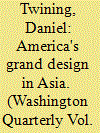

|
|
|
|
|
| Publication |
2007.
|
| Summary/Abstract |
In a dynamic Asian order featuring new centers of power, China's rise will naturally challenge Washington's ability to protect its interests in the region. In 2000, presidential candidate George W. Bush labeled China as the United States' leading strategic and military competitor. In September 2005, Deputy Secretary of State Robert Zoellick explicitly warned Beijing not to "maneuver toward a predominance of power" in Asia, suggesting that it was doing exactly that.
In the face of this challenge, the United States has strengthened the two pillars of its Cold War-era regional security posture: its hub-and-spoke system of bilateral military alliances and its forward-deployed military forces. Washington has reconfigured its permanent troop deployments in Japan and South Korea, tightened its alliance with Australia, declared Thailand and the Philippines to be major non-NATO allies, and signed a wide-ranging strategic cooperation agreement with Singapore. Meanwhile, the Pentagon has deployed significant new power-projection capabilities to the region, including attack submarines, cruise-missile destroyers, long-range bombers, and fighter aircraft stationed in Guam.
To these two preexisting pillars of its Asian security strategy, the United States is adding a third, designed to hedge against the danger of Chinese hegemony in Asia by limiting and constructively channeling China's regional ambitions. U.S. policy seeks to accelerate the economic and military rise of key Asian states with the power potential and ambitions to constrain China's ability to dominate its region. The United States is not working to contain China. Rather, U.S. policymakers are employing a radically different strategy: to preserve Washington's strategic position in the region by facilitating the ascent of friendly Asian centers of power that will both constrain any Chinese bid for hegemony and allow the United States to retain its position as Asia's decisive strategic actor. In the face of the China challenge, the United States is encouraging the emergence of new centers of strength that will not erode U.S. power but protect the U.S. position in a new Asian balance featuring emerging world powers in China, Japan, and India.
|
|
|
|
|
|
|
|
|
|
|
|
|
|
|
|
| 2 |
ID:
080907
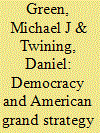

|
|
|
|
|
| Publication |
2008.
|
| Summary/Abstract |
Has democracy promotion been discredited as a central theme of American foreign policy after the US experience in Iraq? Many American critics and friends overseas appear to believe so. It would be wrong, however, to believe that the ideational approach of American foreign policy will diminish, particularly in Asia. First, there is not in fact a tension between the United States' material power and its ideals as a democracy. Second, post-Bush leaders identify and embrace the promotion of bilateral and multilateral cooperation among Asia-Pacific democracies as central to the United States' regional strategy. Third, and most important, democracy promotion and security cooperation among like-minded democracies will remain a central objective of American foreign policy in Asia because those elements magnify American power and facilitate US goals. In short, the ideational balance of power in Asia directly affects the material balance of power. This article examines these trends in American policy in Asia, the outlook for greater strategic and diplomatic cooperation among regional democracies, and the implications for the region, including China and ASEAN, of a US democracy-based approach to Asia policy.
|
|
|
|
|
|
|
|
|
|
|
|
|
|
|
|
| 3 |
ID:
120777
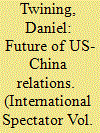

|
|
|
|
|
| Publication |
2013.
|
| Summary/Abstract |
China and the United States have just experienced political transitions that allow the leaders of both countries to focus on bilateral relations free from the pressures of domestic political campaigns. But the domestic politics of the bilateral relationship inside each country are, like the structural tensions between the established power and the rising challenger, intensifying, as Washington takes new steps to assert its primacy in Asia and Beijing works to edge America out of its neighbourhood. US-China relations are likely to be less stable and more prone to conflict over President Obama's second term, unless the two nations can arrive at a modus vivendi to keep the peace in Asia. The challenge is that such an entente likely requires the kind of political change in China its leaders seem determined to block for fear of the threat it would pose to their own legitimacy. The reverberations of a relationship that is conflict-prone, but in which conflict holds such downside risks for both countries, will be felt well beyond Asia.
|
|
|
|
|
|
|
|
|
|
|
|
|
|
|
|
| 4 |
ID:
085851
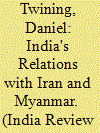

|
|
|
| 5 |
ID:
106692
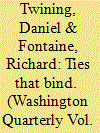

|
|
|
|
|
|
|
|